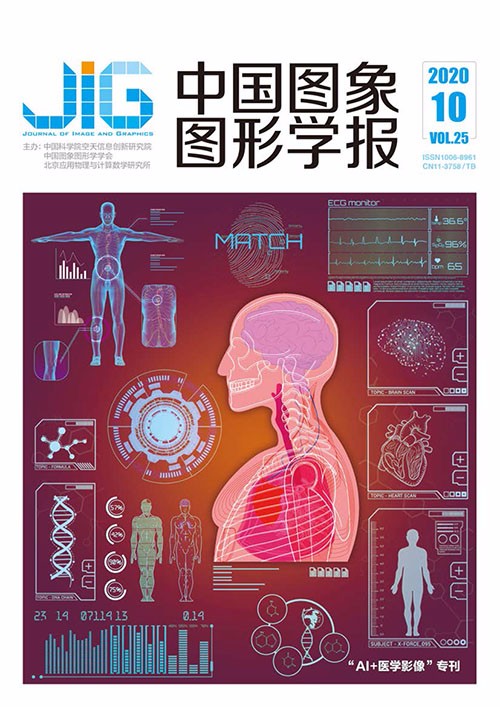
深度学习在医学影像中的应用综述
施俊1, 汪琳琳1, 王珊珊2,3,4, 陈艳霞2,3,4, 王乾5, 魏冬铭5, 梁淑君6, 彭佳林7, 易佳锦7, 刘盛锋8, 倪东8, 王明亮9, 张道强9, 沈定刚10(1.上海大学通信与信息工程学院, 上海 200444;2.中国科学院深圳先进技术研究院保罗·3.C·4.劳特伯生物 医学成像研究中心, 深圳 518055;5.上海交通大学生物医学工程学院, 上海 200030;6.南方医科大学 生物医学工程学院, 广州 510515;7.华侨大学计算机科学与技术学院, 厦门 361021;8.深圳大学医学部 生物医学工程学院医学超声图像计算(MUSIC)实验室, 深圳 518060;9.南京航空航天大学计算机科学与 技术学院, 南京 211106;10.上海联影智能医疗科技有限公司, 上海 200232) 摘 要
深度学习能自动从大样本数据中学习获得优良的特征表达,有效提升各种机器学习任务的性能,已广泛应用于信号处理、计算机视觉和自然语言处理等诸多领域。基于深度学习的医学影像智能计算是目前智慧医疗领域的研究热点,其中深度学习方法已经应用于医学影像处理、分析的全流程。由于医学影像内在的特殊性、复杂性,特别是考虑到医学影像领域普遍存在的小样本问题,相关学习任务和应用场景对深度学习方法提出了新要求。本文以临床常用的X射线、超声、计算机断层扫描和磁共振等4种影像为例,对深度学习在医学影像中的应用现状进行综述,特别面向图像重建、病灶检测、图像分割、图像配准和计算机辅助诊断这5大任务的主要深度学习方法的进展进行介绍,并对发展趋势进行展望。
关键词
Applications of deep learning in medical imaging: a survey
(1.School of Communication and Information Engineering, Shanghai University, Shanghai 200444, China;2.Paul C Lauterbur Research Center, Shenzhen Institutes of Advanced Technology, Chinese Academy of Sciences, Shenzhen 518055, China;3.School of Biomedical Engineering, Shanghai Jiao Tong University, Shanghai 200030, China;4.School of Biomedical Engineering, Southern Medical University, Guangzhou 510515, China;5.College of Computer Science and Technology, Huaqiao University, Xiamen 361021, China;6.Medical UltraSound Image Computing(MUSIC) Laboratory, School of Biomedical Engineering, Health Science Center, Shenzhen University, Shenzhen 518060, China;7.College of Computer Science and Technology, Nanjing University of Aeronautics and Astronautics, Nanjing 211106, China;8.Shanghai United Imaging Intelligence Co., Ltd., Shanghai 200232, China) Abstract
Deep learning can automatically learn from a large amount of data to obtain effective feature representations, thereby effectively improving the performance of various machine learning tasks. It has been widely used in various fields of medical imaging. Smart healthcare has become an important application area of deep learning, which is an effective approach to solve the following clinical problems: 1) given the limited medical resources, the experienced radiologists are not fully available, which cannot satisfy the fast development of the clinical requirement; 2) the lack of experienced radiologists, which cannot satisfy the fast increase of medical demand. At present, deep learning-based intelligent medical imaging systems are the typical scenarios in smart healthcare. This paper primarily reviews the applications of deep learning methods in various applications using four major clinical imaging techniques (i.e., X-ray, ultrasound, computed tomography(CT), and magnetic resonance imaging(MRI)). These works cover the whole pipeline of medical imaging, including reconstruction, detection, segmentation, registration, and computer-aided diagnosis (CAD). The reviews on medical image reconstruction focus on both MRI reconstruction and low-dose CT reconstruction on the basis of deep learning. Deep learning methods for MRI reconstruction can be divided into two categories: 1) data-driven end-to-end methods, 2) model-based methods. The low-dose CT reconstruction primarily introduces methods on the basis of convolutional neural networks and generative adversarial networks. In addition, deep learning methods for ultrasound imaging, medical image synthesis, and medical image super-resolution are reviewed. The reviews on lesion detection primarily focuses on the deep learning methods for lung lesions detection using CT, the deep learning detection model for tumor lesions, and the deep learning methods for the general lesion area detection. At present, deep learning has been widely used in medical image segmentation tasks, and its performance is significantly improved compared with traditional image segmentation methods. Most deep learning segmentation methods are typical data-driven machine learning models. We review supervised models, semi-supervised models, and self-supervised models with regard to the amount of labeled data and annotation. Medical images contain rich anatomical information, which enhances the performance of deep learning models with different supervision. Deep learning models incorporating prior knowledge are also reviewed. Medical image registration consistency is a difficult task in the field of medical image analysis. Deep learning has become a breakthrough to improve the performance of medical image registration. The end-to-end network structures produce high-precision registration results and have become a hotspot in the field of image registration. Compared with the conventional methods, the deep learning methods for medical image registration have a significant improvement in registration performance. According to the different supervision in the training procedure, this paper divides the deep learning methods for medical image registration into three modes: fully supervised methods, unsupervised methods, and weakly supervised methods. Computer-aided diagnosis is another application of deep learning in the field of medical imaging. This paper summarizes the deep learning methods on CAD with different supervision and the CAD works on the basis of multi-modality medical images. Notably, although deep learning methods have been applied in medical imaging, several challenges are still identified. For example, the small-sample size problem is common in medical imaging analysis. Advanced machine learning methods, including weakly supervised learning, transfer learning, few-shot learning, self-supervised learning, and increase learning, can help alleviate this problem. In addition, the data annotation of medical images is a problem that seriously restricts the extensive and in-depth application of deep learning, and extensive research on automatic data labeling must be carried out. Interpretability of the deep neural networks is also important in medical image analysis. Improving the interpretability of a deep neural network has always been a difficult point, and in-depth research must be carried out in this area. Furthermore, carrying out human-computer collaboration in medical care is important. The lightweight deep neural network is easy to deploy into portable medical devices, giving portable devices more powerful functions, which is also an important research direction. Deep learning has been successful in various tasks in medical imaging analysis. New methods must be developed for its further application in intelligent medical products.
Keywords
deep learning medical imaging image reconstruction lesion detection image segmentation image registration computer-aided diagnosis(CAD)
|



 中国图象图形学报 │ 京ICP备05080539号-4 │ 本系统由
中国图象图形学报 │ 京ICP备05080539号-4 │ 本系统由